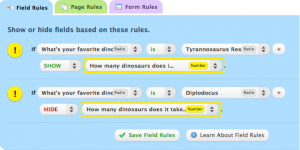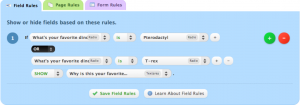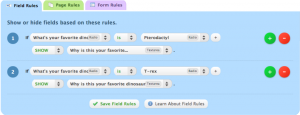 Form logic can be a Wufan’s best friend.
Form logic can be a Wufan’s best friend.
They help you create personalized form-taking experiences and allow you to capture more detailed, thoughtful responses.
That being said, it takes practice to master the different types of form logic—whether it’s Form Rules, Field Rules, or Page Rules.
To help fast-track your development as a form-building wizard, we’ll share 4 common form logic mistakes. We’ll start with a blunder that isn’t about using logic, but about not using it when you should.
Mistake #1: Shying away from logic when your form needs it
If your form goes out to a broad audience, it’s hard to build one-size-fits-all fields.
The answers respondents give can differ quite a bit from one another, and the opportunity to capture additional, key information gets missed when you can’t account for individual opinions and preferences.
For example: Imagine you’re hosting an event and you use an RSVP form to manage attendees.
You ask prospective attendees if they plan on bringing any guests. If you assume that everybody will bring one, and you use later fields to ask about them, you risk annoying those who said they aren’t bringing a guest. These respondents might leave your form, or, equally as bad, give random answers to your follow-up, guest-specific fields.
This situation can easily be prevented with Field Rules—a set of conditions that determine when to show or hide particular fields. Use Field Rules to show guest-specific fields only when a respondent says they plan to bring someone.

In general, if you’re sending your form to a large audience whose responses can vary widely, you’ll likely need to use rules. This blog post can help you decide on the type of rule to use for any situation.
Mistake #2: Relying on Page Rules when Field Rules can do the trick
Going from page to page can easily become exhausting for respondents. It also doesn’t make your life any easier as a form builder.
That’s why you not only want to minimize the number of pages you build in your form, but also the number of Page Rules you set.
Note: Page Rules allow you to skip respondents to specific pages when certain conditions are met.
Page Rules work great for the following cases:
- When you want to potentially disqualify respondents from taking your form, in which case they’d go to your confirmation page
- When respondents want to pay for something on your form, you can take them to the appropriate page—depending on the form of payment (credit card, check, etc.)
- When the differences across your respondents warrant asking specific segments a variety of unique questions
In cases outside of these, try using Field Rules. They’ll effectively determine what to show each form taker without taking them to another page.
Mistake #3: Hiding fields instead of showing them
When you use Field Rules, you’ll be able to decide whether to hide or show fields. Hiding them means that if a respondent meets certain conditions, those fields don’t appear on the form. Otherwise, they will. Showing them is the opposite—fields only appear if your conditions get met.

We recommend you pick show rules over hide rules. Why? Because show rules already hide fields by default.
It also comes down to the form-taking experience. If a respondent sees fields suddenly disappear, it might come across as jarring and confusing. Meanwhile, showing additional fields as respondents fill out the form conveys that you’re listening to them. Also, it provides you with a tidier form, since only the required fields appear.
Mistake #4: Building conflicting rules
Conflicting rules are simply when you have two or more rules that trigger the same field to either appear or hide.
For instance, imagine you want to know why respondents like a Tyrannosaurus (T-rex) or a Pterodactyl the most. You’re less interested in the other dinosaurs respondents might pick because these are the only 2 that really matter, right??
To use the follow-up field “Why do you like this dino?” for respondents who either select a T-rex or a Pterodactyl, you would use a multi-conditional rule.

You can’t do something like the following:

Since these rules overlap with each other on what they show, only the more recent rule (the 2nd one) will work on your form.
Now that you know about the top form logic mistakes and how you can avoid making them, you’re ready to use each type of rule masterfully. Once you do, you’ll be rewarded with higher quality data and more satisfied respondents!

Comments
It is a very interesting article.
Posted October 4th, 2019 by Rabato.It helped me a lot.
Thank you so much.